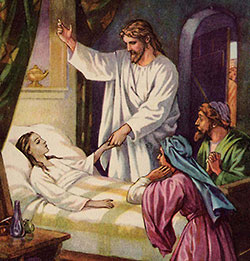
Many years ago I came across a most interesting account of a man who was martyred for his Catholic faith in England. As a young man he was confused by the conflicts between the “old” Catholic religion and the “new” Protestant religion. While attending Oxford University he went to the local Protestant bishop and asked him bluntly: “Which is best, the old religion or the new religion?” Having cast aside the religion of his childhood–and that of more than a thousand years of his ancestors–for the sake of worldly gain in the new religion, the bishop sat quite a while in silence. Then he quietly but firmly said: “For living, the new religion is best; but for dying the old religion is best.” “I may die at any moment,” said the young man, “so the old religion must be the best for me,” and he left to immediately take up the Catholic faith, leaving behind a sad old man who knew that at the hour of death he would not have the grace and blessing of the holy Sacraments.
Having taught that the Bible and personal faith alone were necessary for salvation he would be left with them alone–a bleak prospect, indeed. The young man, on the other hand joyfully lived as a Catholic and, hearing the call: “Come, ye blessed of my Father,” joyfully died a martyr for that precious faith, the faith that three hundred years later won the hearts of Bishop Wedgwood and Bishop Leadbeater, both of whom had grown to manhood in the “new” religion, of which Bishop Leadbeater had been a minister.
Yogic Extreme Unction
The purpose of Extreme Unction is to prepare the initiate of Christ for the transition into higher worlds which, through mistaken identity with the mortal body, we call “death.” Therefore it is done only when departure of the spirit seems imminent. It, too, begins with the invocation by the priest:
In the Name of the Father ✠ and of the Son and of the Holy Spirit. Amen.
Absolution
According to the ritual instructions, in his own words the priest “should exhort the dying man to make a momentary act of contrition and then to turn with love and devotion to the Lord Jesus.” The priest immediately pronounces the absolution from the Anointing of the Sick:
Our Lord Jesus Christ, who hath left power on earth to his Church to absolve all those that with hearty repentance and true faith turn unto him, of his tender compassion forgive thee thine offenses; and by his authority committed unto me I ✠ absolve thee from all thy sins. In the Name of the Father, ✠ and of the Son, and of the Holy Spirit. Amen.
But if there is no time because the person seems right at the point of departure, he uses the following shortened form:
I ✠ absolve thee from all thy sins, in the Name of the Father ✠ and of the Son and of the Holy Spirit. Amen.
Holy unction
The priest anoints the person on the forehead with Oil of the Sick as he says:
By this holy ✠ unction and of His most tender love, the Lord pardon thee whatever faults thou hast committed through thy thoughts and desires and the senses of thy body. R: Amen.
Then he anoints the seven chakras just as in the Anointing of the Sick. In this way the bodies of the person become balanced and harmonious in their functions, for “death” is not a cessation of life but a process of life.
Viaticum–Communion
To assist the person in leaving the body in the highest state of consciousness possible to his level of evolution, he is united to the Consciousness of Christ through the reception of Holy Communion. As he administers Communion to him the priest says:
Brother, receive the Viaticum of the most holy Body [and Blood] of our Lord Jesus Christ, and may the peace of the Lord go with thee. R: Amen.
The blessing
In conclusion the priest blesses the person, saying:
Unto God’s gracious love and protection we commit thee; the Lord ✠ bless thee and keep thee; the Lord make His Face to shine upon thee and be gracious unto thee; the Lord lift up the light of His Countenance upon thee and give thee His peace, now and for evermore. Amen.
After death
If death takes place while the priest is present, he may at once proceed to the Absolution, as set forth in the Order of the Burial of the Dead:
P: Rest in the eternal grant unto him, O Lord.
C: And let light perpetual shine upon him.P: Come forth to meet him, ye Angels of the Lord.
C: Receive him into your fellowship, O ye saints of God.P: May the choirs of Angels receive him.
C: And guide him into eternal peace.P: Rest in the eternal grant unto him, O Lord.
C: And let light perpetual shine upon him.
P: O God, in Whose unspeakable love the souls of the departed find rest and peace, in Thy Name we ✠ absolve from every bond of sin Thy servant who has cast off this garment of flesh. May Thy holy Angels bear him in their tender care, that he may enter the brightness of the everlasting light and find his peace in Thee; through Christ our Lord. R: Amen.
These are not just beautiful words: there will be a response from the angelic realms and the worlds of the saints. Many people fortunate enough to have a religion that understand these things have testified after unexpectedly returning to life that when someone prayed for angels and saints to assist them, angels and saints did indeed come and help them, sometimes showing them higher worlds and then bringing them back to re-enter their body. This is the difference between a real religion and a theoretical one.
Next in Yoga of the Sacraments: Blessing of Holy Water







